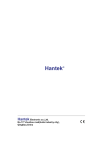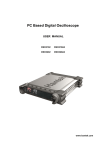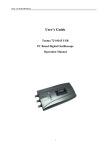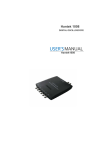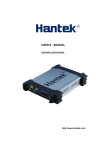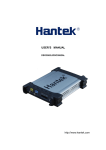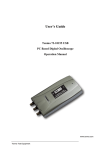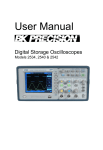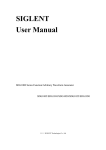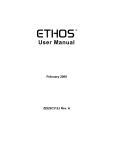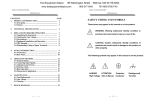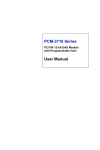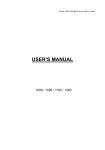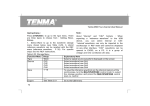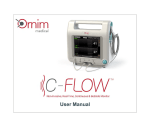Download Manual for 60MHz Four Channel USB Oscilloscope
Transcript
USER’S MANUAL Tenma 72-10175 www.tenma.com Tenma Test Equipment 405 S.Pioneer Blvd.Springboro,OH 45066 TENMA 72-10175 DIGITAL OSCILLOSCOPE USER’S MANUAL 72-10175 X Content General Safety Summary ……..………………………….…..3 CHAPTER 1: Getting Started…...…………………………... 4 System Requirement..………………………………....5 Install Software........………………………………...…6 Install Driver............……………………………….....11 General Features....………………………………….16 General Check............…………………………….....17 Probe Compensation.................…………………....17 Functional Check.................………………..……....19 Self Calibration........................................................21 Accessaries.............................................................22 CHAPTER 2: Operating Basics……………………………..23 The User’s Inerface…………………………………...24 The Vertical System…...........………………………..30 The Horizontal System…………………….....……...32 The Trigger System............................……………...33 Input Connectiors..…………………………………...35 CHAPTER 3:Functions..……………… ..…………………...36 Set Ocsilloscope.....................................................37 Set Vertical System.................................................38 Set Horizontal System............................................47 Set Trigger System.................................................55 Save/Load..............................................................55 Utility Function........................................................57 Measure Signal.......................................................65 The Display System................................................73 Zoom In/Out and Drag waveforms..........................78 Interpolation............................................................80 Acquisition..............................................................83 Print........................................................................84 CHAPTER 4: Application Example......………………….....86 Simple Measurement..............................................87 Pass/Fail Test..........................................................89 Capturing a Single Shot Signal...............................93 The Application of The X-Y.......................................94 Taking Cursor Measurements...................................97 CHAPTER 5: Appendix..............……………………...101 Appendix A.............................................................102 Appendix B.............................................................106 Y TENMA 72-10175 DIGITAL OSCILLOSCOPE General Safety Summary Review the following safety precautions carefully before operate the device to avoid any personal injuries or damages to the device and any products connected to it. To avoid potential hazards use the device as specied by this user’s guide only. To Avoid Fire or Personal Injury Use Proper Power Cord. Use only the power cord specied for this product and certied for the country of use. Connect and Disconnect Properly. Do not connect or disconnect probes or test leads while they are connected to a voltage source. Connect and Disconnect Properly. Connect the probe output to the measurement device before connecting the probe to the circuit under test. Disconnect the probe input and the probe reference lead from the circuit under test before disconnecting the probe from the measurement device. Observe All Terminal Rating. To avoid re or shock hazard, observe all ratings - and markings on the product. Consult the product manual for further ratings information before making connections to the product. Use Proper Probe. To avoid shock hazard, use a properly rated probe for your meas-urement. Avoid Circuit or Wire Exposure. Do not touch exposed connections and compo nents when power is on. Do Not Operate With Suspected Failures. If suspected damage occurs with the device, have it inspected by qualied service personnel before further operations. Provide Proper Ventilation. Refer to the installation instructions for proper ventilation of the device. Do not operate in Wet/Damp Conditions. Do not operate in an Explosive Atmosphere. Keep Product Surfaces Clean and Dry. Z Chapter 1 Getting Start The 72-10175 is small, lightweight, portable oscilloscope which does not require external power! The 72-10175 is ideal for production test,research,design and any other applications involving analog circuits test and troubleshooting, as well as education and training. In addition to the list of general features on the next page, this chapter describes how to do the following tasks: System Requirements Install your product General Features General Check Perform a probe check and compensate probes Match your probe attenuation factor Use the self calibration routine Accessories [ TENMA 72-10175 DIGITAL OSCILLOSCOPE System Requirement To run the oscilloscope software, the needs of computer conguration are as follows: Minimum System Requirements Operating System Window NT/2000/XP/VISTA/Win7 Processor 1.00GHz processor Memory 256MB Disk Space 500M disk free space Screen resolution 800 x 600 Recommended Conguration Operating System Windows XP SP3 System Processor 2.4G Processor Memory 1GB Memory Disk Space 80GB Disk Space Screen resolution 1024 x 768 or 1280 x 1024 resolution DPI Setting Normal Size (96DPI) \ Install Software Caution: You must install the software before using the oscilloscope. 1. While in Windows, insert the installation CD into the CD-ROM drive. 2. The installation should start up automatically. Otherwise in Windows Explorer, switch to the CD-ROM drive and run Setup.exe. 3. The software Installation is started. Click 'Next' to continue. 4. Choose a destination directory. Click 'Next' to continue. ] TENMA 72-10175 DIGITAL OSCILLOSCOPE 5. Check the setup information. Click Next to start copying of les. ^ 6. This Status dialog is displayed during copying of les. _ TENMA 72-10175 DIGITAL OSCILLOSCOPE 7. Updating Your System Conguration. ` 8. The installation is complete. XW TENMA 72-10175 DIGITAL OSCILLOSCOPE Install Driver 1. Connect the A-Type Plug of USB cable to your PC’S USB port. 2. Connect the B-Type Plug of USB cable to USB’S USB port. 3. New hardware is found. 4. New hardware search wizard starts. XX 5. Select the specic location. XY TENMA 72-10175 DIGITAL OSCILLOSCOPE 6. New hardware search wizard starts to search the driver. XZ 7. New hardware wizard installs “USB DRIVER ”. X[ TENMA 72-10175 DIGITAL OSCILLOSCOPE 8. The wizard has nished installing for “USB DRIVER”. X\ General Features Product features: Four channel,Bandwidth: 60MHz Maximum real-time sample rate: 200MSa/s Memory depth: 10K-16M points Automatic setup for ease of use (AUTOSET); Pass/Fail; Built-in Fast Fourier Transform function(FFT); 20 Automatic measurements; Automatic cursor tracking measurements; Waveform storage, record and replay dynamic waveforms; User selectable fast offset calibration; Add, Subtract and Multiply Mathematic Functions; Selectable 20 MHz bandwidth limit; External trigger; Waveform average; Adjustable waveform intensity, more effective waveform view; User interface in several user-selectable languages; X] TENMA 72-10175 DIGITAL OSCILLOSCOPE General Check Please check the instrument for the following steps before use. Check the shipping container for damage: Keep the damaged shipping container or cushioning material until the contents of the shipment have been checked for completeness and the instrument has been checked mechanically and electrically. Check the accessories: Accessories supplied with the instrument are listed in "Accessories" in this guide. If the contents are incomplete or damaged,please notify the distributor. Check the instrument: In case there is any mechanical damage or defect, or the instrument does not operate properly or fails performance tests, please notify the distributor.. Probe Compensation Perform this function to match the characteristics of the probe and the channel input. This should be performed whenever attaching a probe to any input channel at the rst time. From the “Probe” menu, select attenuation to 1:10. Set the switch to “X10” on the probe and connect it to CH1 of the oscilloscope. When using the probe hook-tip, insert the tip onto the probe rmly to ensure a proper connection. Attach the probe tip to the Probe Compensator and the reference lead to the ground connector, select CH1, and then press the “AUTOSET“ button into the menu or the toolbar. Check the shape of the displayed waveform. X^ Correctly Compensated Over compensated X_ TENMA 72-10175 DIGITAL OSCILLOSCOPE Under Compensated If necessary, use a non-metallic tool to adjust the trimmer capacitor of the probe for the attest square wave being displayed on the oscilloscope. Repeat if necessary. WARNNING: To avoid electric shock while using the probe, be sure the perfection of the insulated cable, and do not touch the metallic portions of the probe head while it is connected with a voltage source. Function Check Perform this functional check to verify that your oscilloscope is operating correctly. Connect the oscilloscope You should connect the A-Type Plug of USB cable to your PC USB port and connect the B-Type Plug of USB cable to oscilloscope USB port. X` Input a signal to a channel of the oscilloscope The oscilloscope is equipped with four channels plus external trigger. Please input signal in the following steps: 1. Set the attenuation switch on the probe as 10X and connect the probe on the oscilloscope with CH1. Allign the slot in the probe connector at the end on BNC of CH1 and insert, then, turn right to lock the probe. Finally, attach the tip of probe and ground nip to the Connector of Probe compensator. 2. Set the CH1 probe attenuation of the oscilloscope to X10. (The default is X1). YW TENMA 72-10175 DIGITAL OSCILLOSCOPE 3. Attach the tip of probe and ground nip to the Connector of Probe compensator. Click the button. A square wave will be displayed within a several seconds. (Approximately 1 kHz, 2V, peak- to- peak). 4. Inspect CH2 ,CH3 and CH4 with the same method. Repeat steps 2 and 3. Self Calibration The self calibration routine lets you optimize the oscilloscope signal path for maximum measurement accuracy. You can run the routine at any time but you should always run the routine if the ambient temperature changes by 5v or more. For accurate calibration, power on the oscilloscope and wait twenty minutes to ensure it is warmed up. To compensate the signal path, disconnect any probes or cables from the input connectors. Then, access the “Utility -> Calibration” option and follow the directions on the screen. The self calibration routine takes about several minutes. YX Accessories All the accessories listed below are standard accessories for the oscilloscope: Probe×2 (1.5m), 1:1, (10:1) Passive Probes A User’s Guide An USB Cable A PC software of the oscilloscope YY TENMA 72-10175 DIGITAL OSCILLOSCOPE Chapter 2 Operating Basics The User’s Interface The Menu System The Vertical System The Horizontal System The Trigger System Input Connectors YZ The User’s Interface Click the software icon on the desk after you nished the software setting and equipment connecting. Then a user interface will be showed as follows: In addition to displaying waveforms, the display area is lled with many details about the waveform and the oscilloscope control settings. 1. The Main Menu All settings can be found in the main menu. 2. The Toolbar 3. Displays the trigger information Displays the edge trigger slope, source and level. 4. The Horizontal Panel Y[ TENMA 72-10175 DIGITAL OSCILLOSCOPE The user can change Time/Div, format in the panel. 5. The Vertical Panel The user can turn on/off the CH1/CH2/CH3/CH4. Also the user can change the CH1/ CH2/CH3/CH4 volt/div, coupling and probe attenuation. 6. The Trigger Panel In this panel, the user can change the trigger mode, sweep, source and slope. 7. Displays the system time. 8. Marker shows Edge trigger level. 9. Displays the main time base setting. 10. Displays the CH4 information Readouts show the coupling of the channels. Readouts show the vertical scale factors of the channels. A “B” icon indicates that the channel is bandwidth limited. 11. Displays the CH3 information Readouts show the coupling of the channels. Readouts show the vertical scale factors of the channels. A “B” icon indicates that the channel is bandwidth limited. 12. Displays the CH2 information Readouts show the coupling of the channels. Readouts show the vertical scale factors of the channels. A “B” icon indicates that the channel is bandwidth limited. 13. Displays the CH1 information Readouts show the coupling of the channels. Readouts show the vertical scale factors of the channels. A “B” icon indicates that the channel is bandwidth limited. 14. Displays the software status. 15. The markers show the reference points of the displayed waveforms. If there is no marker, the channel is not displayed. 16. The same above. 17. The same above. 18. The same above. Y\ 19. A window that shows the display waveform in buffer position. 20. Marker shows horizontal trigger position. 21. Trigger status indicates the following: AUTO: The oscilloscope is in auto mode and is acquiring waveforms in the absence of triggers. Trig’D: The oscilloscope has seen a trigger and is acquiring the post trigger data. WAIT: All pretrigger data has been acquired and the oscilloscope is ready to accept a trigger. STOP: The oscilloscope has stopped acquiring waveform data. RUN: The oscilloscope is running. PLAY: The oscilloscope is displaying the record waveforms. The Menu System The Main Menu 1. File: Load or Save data, setup 2. View: Change the user interface Y] TENMA 72-10175 DIGITAL OSCILLOSCOPE 3. Setup: Setup setting 4. Display: Change wave display type 5. Cursor: Set Cursor measure type 6. Measure: Set measurement parameters 7.Acquire: Run ,Stop or other operation setting Y^ 8. Utility: Utility setting 9. Window: Window setting 11. Help: Access help le Y_ TENMA 72-10175 DIGITAL OSCILLOSCOPE Y` The Vertical System Click “Setup”->” Vertical” The following gure shows the vertical Setup window. It shows the vertical parameters setting. 1. Select channel : User can select the channel by clicking the Combo box. 2. ON/OFF: Turn on or off the selected channel. ZW TENMA 72-10175 DIGITAL OSCILLOSCOPE 3. VOLTS/DIV: Set the selected channel voltage range. 4. Coupling: Set the selected channel to DC/AC. 5. Probe: Set the Select one according to the probe attenuation factor to ensure correct vertical scale reading 6. BW Limit: Reject the frequency component higher than 20MHz. 7. Invert: Invert the selected wave. ZX The Horizontal System Click ”Setup”->“Horizontal” The following gure shows the Horizontal System window. It shows the horizontal parameters settings. 1. Time/DIV: leads the setting of the time base parameters 2. Format: leads the setting of the horizontal format parameters ZY TENMA 72-10175 DIGITAL OSCILLOSCOPE The Trigger System Click “Setup”-> “Trigger” The following gure shows the trigger system control. 1. Trigger Mode: Sets the trigger mode 2. Trigger Sweep: Selects the trigger sweep mode to AUTO, NORMAL or SINGLE ZZ 3. Tirgger Source: Selects the trigger source to CH1, CH2, ALT, EXT or EXT/10 4. Trigger Slope: Selects the edge trigger slope to Positive or Negative slope Z[ TENMA 72-10175 DIGITAL OSCILLOSCOPE Input Connector CH1/CH2/CH3/CH4: Input connectors for waveform display. EXT.: Input connector for an external trigger source. Use the Trigger Menu to select the Ext. or Ext./10 trigger source. Other Connector: GND.: Ground terminal USB PORT: Connect the B-Type Plug of USB cable to this port. CAL.: Probe compensation output. Z\ Chapter 3 Understanding Oscilloscope Functions Set Oscilloscope Set Vertical System Set Horizontal System Set Trigger System Save/Load Utility Function Measure Signal Zoom In/Out Waveforms Acquire Signal Print Z] TENMA 72-10175 DIGITAL OSCILLOSCOPE Setup the Oscilloscope Using “AUTOSET” to display a signal automatically Auto setup functions one time each time you push the “AUTOSET” button. The function obtains a stable waveform display for you. It automatically adjusts the vertical scale, horizontal scale and trigger settings. Auto setup also displays several automatic measurements in the graticule area, depending on the signal type. Connect a signal to the CH1 input: 1. Connect a signal to the oscilloscope as described above. 2. Click the “Acquire -> Autoset” button. The oscilloscope will change the current settings to display this signal. Save Setup The oscilloscope software saves the current setup before you close the oscilloscope software. The oscilloscope recalls this setup the next time you run the software. You can use the “Save Setup” menu to permanently save up to several different setups. Load Setup The oscilloscope can recall the last setup before the oscilloscope software was running, any saved setups, or the factory setup. You can use the “Load Setup” menu to permanently recall a setup. Factory Setup The oscilloscope software is set up for normal operation when it is shipped from the factory. This is the factory setup. To recall this setup, push the “Factory Setup” menu. Z^ Set Vertical System Set Channel Click “Vertical” in “Setup” Menu. The Channel Selection The Channel Control Panel in sidebar The Vertical function: Turn ON/Off: Turn on/off the channel Volt/DIV: Select the channel voltage/div Coupling: Select the channel coupling Probe: Select the channel probe attenuation Filter: Select software lter Reset: Set the channel vertical position to zero Invert: Turn on/off the invert function. BandWidth Limit: Limit the channel bandwidth to 20MHz to reduce noise. Change Volt/DIV You can click “Volt/Div” in “Vertical Setup” window to select the voltage Z_ TENMA 72-10175 DIGITAL OSCILLOSCOPE You can also change the selected channel voltage in sidebar You can left click and drag the mouse on the knob to change the voltage. Set Channel Coupling Click “Coupling” in “Vertical Setup” window In the sidebar, you can change the channel coupling too. You can set the coupling to DC, AC or GND. If you set the coupling to DC, it blocks the AC component of the input signal. Probe Attenuation Setting Select the attenuation factor for the probe. To check the probe attenuation setting, toggle the probe menu to match the attenuation factor of the probe. This setting remains in effect before you changed again. Z` Click “Probe” in Vertical Setup window to select the probe attenuation The probe setting window in the sidebar Note: The attenuation factor changes the vertical scale of the oscilloscope so that the measurement results reect the actual voltage levels at the probe tip. Invert The invert function turns the displayed waveform 180 degrees, with respect to the ground level. When the oscilloscope is triggered on the inverted signal, the trigger is also inverted. Click “Invert” in Vertical window The following picture shows the waveform before inversion: [W TENMA 72-10175 DIGITAL OSCILLOSCOPE The following picture shows the waveform of inversion: [X Set the Channel Bandwidth Limit The oscilloscope is set to full bandwidth and will pass the high frequency component in the signal if the “BW Limit” was turned off. The oscilloscope will reject the frequency component higher than 20MHz if the “BW Limit” was turned on. When the “BW Limit” was turned on, a “B” sign will be displayed at the bottom of display screen. Set Math Click “MATH” in Channel menu to set MATH channel. The MATH Setup window [Y TENMA 72-10175 DIGITAL OSCILLOSCOPE ON/OFF: Turn On/Off the MATH Channel. Source A/B: Set the sources of the math channel. Operate: Set operates type of the math channel. Volt/DIV: Set the resolution of the math channel. Probe: Set the math channel probe attenuation. Invert: Turn on/off the invert function The mathematic functions include addition, subtract, multiply and FFT for CH1, H2,CH3 and CH4. Source A/B Source A and Source B Menu [Z Operate Four Types: A+B Add source A and source B A-B Subtract source B from source A A×B Multiply source A by source B FFT Convert a time-domain signal into its frequency components (spectrum). In this function, use the addition, subtraction, multiplication and FFT function to operate and analyze the waveform. Select the operation type in the Operate menu. Select source A and B. Then adjust the vertical scale and offset to view the math channel clearly. The mathematic result can be measured by the measure and the cursor. The Math Function Display Set Reference [[ TENMA 72-10175 DIGITAL OSCILLOSCOPE Click “REF” in “Setup” menu to set REF channel. The Reference Channel Function: On/Off: Turn on/off the reference channel. Volt/DIV: Select the resolution of the reference channel. Load: Load the reference waveform from the “.rfc” le from your computer. Save: Save the current reference waveform to your computer as “.rfc” format. Save Reference: Save the current reference waveform to your computer as “.rfc” format. You can change the vertical scale of a waveform. The waveform display will contract or expand relative to the reference level. Load Click “Load” to load the *.rfc le that was selected. The load le window will appear. Save Click “Save ” to save the waveform to *.rfc le. The saved source window appears. [\ The save le window will appear after you selected the saved source. The Reference Waveform Display Window: Note: If you turn on the “Reference” channel, the load le window will appear. [] TENMA 72-10175 DIGITAL OSCILLOSCOPE Setup Horizontal System Change Time/Div The “Time/Div” Selects the horizontal Time/DIV (scale factor) for the main or the window time base The Horizontal Panel Click the blue knob can change Time/Div. If the waveform acquisition is stopped, Time/Div control expands or compresses the waveform. Change Format Click “Time/Div” you can Set the Time base in Horizontal Setup window In the “Format” item, set the waveform display format (Y-T, X-Y and Roll). Y – T: Show the relative relation between vertical voltage and horizontal time Roll: In Roll Mode, the waveform display updates from right to left X – Y: Show CH1 value at X axis; CH2 value at Y axis [^ In Roll mode, the waveform display rolls from right to left. No trigger or horizontal offset control of waveforms is available during Roll Mode, and it’s only available when set to 1s/div or slower. Note: If the time/div bigger than 1s, the format will change to Roll mode automatically. Change Horizontal Position Double click the channel button to set the trigger point to the horizontal center of the screen. Horizontal position changes the displayed waveform position, relative to the trigger point. The user can drag on screen to change the horizontal position. [_ TENMA 72-10175 DIGITAL OSCILLOSCOPE Set Trigger System Set Edge Trigger The trigger determines when the oscilloscope starts to acquire data and display a waveform. When a trigger is set up properly, it can convert unstable displays or blank screens into meaningful waveforms. If the oscilloscope wants to acquire a waveform, it collects enough data so that it can draw the waveform to the left of the trigger point. The oscilloscope continues to acquire data while waiting for the trigger condition to occur. The oscilloscope continues to acquire enough data so that it can draw the waveform to the right of the trigger point after it detects a trigger. The Edge trigger determines whether the oscilloscope nds the trigger point on the rising or the falling edge of a signal. Select Edge trigger mode to trigger on Rising edge or Falling edge. Mode: Select the trigger mode. Sweep: Set the sweep mode to Auto, Normal or Single. Auto: Acquire waveform even when no trigger occurred Normal: Acquire waveform when trigger occurred. Single: Acquire waveform when trigger occurred then stop Source: You can use the trigger source options to select the signal that the oscilloscope uses as a trigger. The source can be any signal connected to a channel BNC, or to the EXT. BNC. [` CH1: Select CH1 as trigger signal CH2: Select CH2 as trigger signal CH3: Select CH3 as trigger signal CH4: Select CH4 as trigger signal EXT: Select EXT as trigger signal Slope: Set the slope to Rising (+) or Falling (-). Rising: Trigger on rising edge Falling: Trigger on falling edge The user can also change the trigger setting on trigger panel in sidebar. High Frequency Rejection Select “HF Rejection” in “Trigger Setup” window \W TENMA 72-10175 DIGITAL OSCILLOSCOPE The user can turn on “HF Rejection” to ignore triggers from higher frequencies (20M above). Set Pulse Trigger Pulse trigger occurs according to the width of pulse. The abnormal signals can be detected through setting up the pulse width condition. Mode: Select the trigger mode to Pulse. Sweep: Set the sweep mode to AUTO, NORMAL or SINGLE. AUTO: Acquire waveform even when no trigger occurred \X NORMAL: Acquire waveform when trigger occurred. SINGLE: Acquire waveform when trigger occurred then stop Source: You can use the trigger source options to select the signal that the oscilloscope uses as a trigger. The source can be any signal connected to a channel BNC, or to the EXT. BNC. CH1: Select CH1 as trigger signal CH2: Select CH2 as trigger signal CH3: Select CH3 as trigger signal CH4: Select CH4 as trigger signal EXT: Select EXT as trigger signal PW Condition: Set the PW Condition to the following condition. +More: +Pulse width more than set pulse condition. +Less: +Pulse width less than set pulse condition. +Equal: +Pulse width equal to set pulse condition. -More: -Pulse width more than set pulse condition. -Less: -Pulse width less than set pulse condition. -Equal: -Pulse width equal to set pulse condition. Pulse Width: The Pulse Width adjust range is 10ns~10s. When the condition is met ,it will trigger and acquire the waveform. \Y TENMA 72-10175 DIGITAL OSCILLOSCOPE The user can also change the trigger setting on trigger panel in sidebar. When the alternative trigger is on, the trigger sources come from two vertical channels. This mode can be used to observe two non-related signals. You can choose two different trigger modes for the four vertical channels. Set ALT System Mode: Select the trigger mode. Trigger Channel: Set the Trigger Channel to CH1,CH2,CH3 or CH4. \Z Trigger Type: Set the Trigger Type to Edge or Pulse. PW Condition: Set the PW Condition to the following condition. +More: +Pulse width more than set pulse condition. +Less: +Pulse width less than set pulse condition. +Equal: +Pulse width equal to set pulse condition. -More: -Pulse width more than set pulse condition. -Less: -Pulse width less than set pulse condition. -Equal: -Pulse width equal to set pulse condition. Pulse Width: The Pulse Width adjust range is 10ns~10s. When the condition is met, it will trigger and acquire the waveform. The user can also change the trigger setting on trigger panel in sidebar. \[ TENMA 72-10175 DIGITAL OSCILLOSCOPE Save/Load Save Click “File” in main menu to save waveform, setups and screen 1. Save Data Save waveform data as a type le \\ 2. Save Setup Save the current oscilloscope setup to le 3. Save Image Save the software display window as a .bmp or .jpg le Load Click “File” in main menu to recall saved waveform, setup 1. Load Data Load the waveform that had saved as a type le 2. Load Setup Load the instrument that had saved \] TENMA 72-10175 DIGITAL OSCILLOSCOPE Utility/Function Record and Play Back Click “Record” in “Utility” menu. The Record window will display. The following picture shows the Record Interface. \^ This function can record input waveform form CH1,CH2,CH3, or CH4. The maximum record length is 1000 frames. Record Setup window Source: Select record source channel. (CH1, CH2, CH3 or CH4) End Frame: \_ TENMA 72-10175 DIGITAL OSCILLOSCOPE Set the number of record times. The max frames are 1000. Record: Record counter, displays the record frames. “Start” button: Start to record frames. After you start to record waveforms, this button changes to “Stop” button. It stops recording waveforms. Play back setup window Start Frame: Set the start frame of play back. End Frame: Set the end frame of play back. Current Frame: Displays the current frame of play back. You can also change this number to watch the waveform one by one. “Play” button: Click this button to start playing back waveform. It can stop playing back if you started playing back. “Load” button: Click this button to load a record setup. Note: When it plays back waveform, the other channel will be turned off. \` Pass/Fail Click “Pass/Fail” in “Utility” menu The Pass/Fail window appears: The Pass/Fail function monitors changes of signals and outputs pass or fail signals by comparing the input signal with the pre-created mask. Control Setting ]W TENMA 72-10175 DIGITAL OSCILLOSCOPE Source: Select the Pass/Fail channel Output: Select the Pass/Fail output condition Stop When Output: If it was checked, the Pass/Fail will stop when output. Mask Setting Vertical: Set the vertical limit range Horizontal: Set the horizontal limit range “Create” button: ]X Click this button to create Pass/Fail area according to the mask “Save” button: Click this button to save the setups to le. “Load” button: Click this button to load the saved setups le. Information Display Fail: Displays the fail waveform number Pass: Displays the pass waveform number Total: Displays the l total Pass/Fail waveform number Operation Click “Start” button to start the Pass/Fail test. Click “Stop” button to stop the Pass/Fail test. The Pass/Fail function display ]Y TENMA 72-10175 DIGITAL OSCILLOSCOPE NOTE: Pass/Fall function is unavailable In X-Y mode and Roll mode. Factory Setup Click “Factory Setup” in “Utility” menu to load default setups ]Z When you click the Factory Setup in Utility menu, the oscilloscope displays the CH1 and CH2 waveforms and removes all other waveforms. The oscilloscope set up for normal operation when it is shipped from the factory and can be recalled at anytime by user. The Factory Setup function does not reset the following settings: Language option Date and time Language Click “Language” in “Utility” menu There are four languages in “Language” menu. The default language is English. ][ TENMA 72-10175 DIGITAL OSCILLOSCOPE Measure Signal Cursor Menu Click “Cursor” in main menu This method allows you to take measurements by moving the cursors 1. Source The user can set the source to CH1, CH2, CH3,CH4 and MATH. When you use cursors, be sure to set the Source to the waveform on the display that you want to measure. 2. Type There are four types of cursors: Cross, Trace, Vertical and Horizontal 1) Cross The Cross cursors appear as cross lines on the display and measure the vertical and ]\ horizontal parameters. The Cross cursor display window The Cross measure result displays on status bar 2) Trace The Trace cursors appear as vertical lines on the display and measure the waveform amplitude at the point the waveform crosses the cursor. The Trace cursor display window ]] TENMA 72-10175 DIGITAL OSCILLOSCOPE The Trace cursor measure result displays on status bar 3) Vertical The Vertical cursors appear as vertical lines on the display and measure the vertical parameters. The Vertical cursor display window ]^ The Vertical cursor measure result displays on status bar 4) Horizontal The Horizontal cursors appear as horizontal lines on the display and measure the horizontal parameters. The Horizontal cursor display window ]_ TENMA 72-10175 DIGITAL OSCILLOSCOPE The Horizontal cursor measure result displays on status bar Measure Menu Click “Measure” in main menu The oscilloscope provides 20 parametric auto measurements (12 voltage and 8 time measurements). ]` 1. Source The user can use the “Source” menu to select a measure source. 2. Vertical Maximum: Voltage of the absolute maximum level, Measured over the entire waveform Minimum: Voltage of the absolute minimum level, Measured over the entire waveform Peak To Peak: Peak-to-peak = Max – Min, Measured over the entire waveform Top: Voltage of the statistical maximum level, Measured over the entire waveform Base: Voltage of the statistical minimum level, Measured over the entire waveform Middle: Voltage of the 50% level from base to top ^W TENMA 72-10175 DIGITAL OSCILLOSCOPE RMS: The Root Mean Square voltage over the entire waveform Amplitude: Amp = Base – Top, Measured over the entire waveform Mean: The arithmetic mean over the entire waveform Cycle Mean: The arithmetic mean over the rst cycle in the waveform Preshoot: Positive Overshoot = (Max - Top)/Amp x 100 %, Measured over the entire waveform Overshoot: Negative Overshoot = (Base - Min)/Amp x 100 %, Measured over the entire waveform 3. Horizontal Period: Time to take for the rst signal cycle to complete in the waveform Frequency: Reciprocal of the period of the rst cycle in the waveform Rise Time: Time taken from lower threshold to upper threshold Fall Time: Time taken from upper threshold to lower threshold +Duty Cycle: Positive Duty Cycle = (Positive Pulse Width)/Period x 100%, Measured of the rst cycle in waveform -Duty Cycle: Negative Duty Cycle = (Negative Pulse Width)/Period x 100%, Measured of the rst cycle in waveform ^X +Pulse Width: Measured of the rst positive pulse in the waveform. The time between the 50% amplitude points -Pulse Width: Measured of the rst negative pulse in the waveform. The time between the 50% amplitude points 4. Clear Measure Clear all measure items on display screen. The Measure Display Window Note: The results of the automatic measurements will be displayed on the bottom of the screen. Maximum 8 results can be displayed at the same time. When there is no room, the next new measurement result will make the previous results move left, out of screen. ^Y TENMA72-10175 DIGITAL OSCILLOSCOPE The Display System Display Type Click “Type” in “Display” menu. The following gure shows the type parameters setting. If the Vectors type mode is selected, the waveform will be displayed as following gure. If the Dots type mode is selected, the waveform will be displayed as following gure. ^Z Display Grid Click “Display” in main menu The grid shows: ^[ TENMA 72-10175 DIGITAL OSCILLOSCOPE without the grid displayed: ^\ Intensity and Persistence Click “Display->Intensity” in main menu The following gure shows the intensity dialog. It shows the display parameters setting. ^] TENMA 72-10175 DIGITAL OSCILLOSCOPE You can change the grid and waveform color intensity in this dialog. ^^ Zoom In/Out and Drag Waveforms The software will stop updating waveform after the user clicks “ Stop ” button, The user can change the waveform display by adjusting the scale and position. When you change the scale, the waveform display will increase or decrease in size. When you change the position, the waveform will move up, down, right, or left. The channel reference indicator identies each waveform on the display. The indicator points to the reference level of the waveform record. Zoom In/Out The user can click “Zoom In/Out” in “Acquire” menu, then left or right click the mouse button on display screen to zoom in/out the waveform. Also the user can change Time/ Div in Horizontal menu or in Horizontal panel to zoom in/out the waveform. Drag The user can modify the waveform position after clicked “Drag” in “Acquire” menu following the following steps. ^_ TENMA 72-10175 DIGITAL OSCILLOSCOPE 1. Select Channel: 2. Set the Move Step: 3. Change the waveform position: ^` Interpolation At the time base 40ns/div or faster, user can use the 3 different interpolation mode to get waveforms of different clarity. The Step Interpolation The Linear Interpolation _W TENMA 72-10175 DIGITAL OSCILLOSCOPE The Sin(x)/x Interpolation _X Note: The default interpolation mode is Sin(x)/x. Acquisition When you acquire a signal, the oscilloscope converts it into a digital form and displays a waveform. The acquisition mode denes how the signal is digitized and the time base setting affects the time span and level of detail in the acquisition. _Y TENMA 72-10175 DIGITAL OSCILLOSCOPE Acquisition Modes There are two acquisition modes: Normal and Average. Normal: In this acquisition mode, the oscilloscope samples the signal in evenly spaced intervals to construct the waveform. Average: In this acquisition mode, the oscilloscope acquires several waveforms, averages them, and displays the resulting waveform. You can use this mode to reduce random noise. ETSIn this acquisition mode, you can test high frequency cycle signal. _Z Print And Print Preview 1. Click “Print” in “File” menu to set the printer to print the current waveform. The Print report _[ TENMA 72-= 10175 DIGITAL OSCILLOSCOPE 2. Click the “PrintPreview” in “File” menu to get into the Preview window. In”PrintPreview” window, use the “Zoom In” button and the “Zoom Out” button to change the size of the waveform graph. Click the “Close” button to turn this window off and click the “Print” button to print the report. _\ Chapter 4 Application Examples Sample Measurement Pass/Fail Test Capturing a Single-Shot Signal The Application of the X-Y Taking Cursor Measurement _] TENMA 72-10175 DIGITAL OSCILLOSCOPE Simple Measurement To acquire and display a signal, follow these steps: 1. Connect signal to CH1 by using probe 2. Click the "AUTO" button on toolbar or “ Acquire -> Auto Setup” on menu. The Tenma set the vertical, horizontal, and triggers controls at the best status automatical ly. Also, you can adjust the controls to meet your measurement to optimize the waveform display. To measure the frequency and “Vpp”, follow these steps: 1. Click the “Measure->Horizontal->Frequency” button, the frequency of the signal display on the bottom of the waveform interface. 2. Click the “Measure->Vertical->Peak-to-Peak” button, the “Vpp” of the signal will also display on the bottom of the waveform interface. 3. To clear the measurement on the waveform interface, click the “Measure->Clear Measure” button. _^ __ TENMA 72-10175 DIGITAL OSCILLOSCOPE Pass/Fail Test The Pass/Fail function monitors changes of signals and outputs pass or fail signals by comparing the input signal with the pre-created mask. Control Setting Source: Select the Pass/Fail channel Output: _` Select the Pass/Fail output condition Stop When Output: If it was checked, the Pass/Fail will stop when output. Mask Setting Vertical: Set the vertical limit range Horizontal: Set the horizontal limit range “Create” button: Click this button to create Pass/Fail area according to the mask “Save” button: Click this button to save the setups to le. “Load” button: Click this button to load the saved setups le. Information Display `W TENMA 72-10175 DIGITAL OSCILLOSCOPE Fail: Displays the fail waveform number Pass: Displays the pass waveform number Total: Displays the total Pass/Fail waveform number Operation Click “Start” button to start the Pass/Fail test. Click “Stop” button to stop the Pass/Fail test. The Pass/Fail function display `X NOTE: Pass/Fall function is unavailable In X-Y mode and Roll mode. `Y TENMA 72-10175 DIGITAL OSCILLOSCOPE Capturing a Single-Shot Signal To capture a single event, it needs to gather some pre-test knowledge of the signal in order to set up the trigger level and slope correctly. For example, if the event is derived from 3.3V COMS logic, a trigger level of 1.2 or higher Volts should work on a rising edge. Do these steps as follows: 1. Set the probe and the channel attenuations to X 10. 2. Set up the trigger in the Trigger Menu, or in the Trigger Setting window. 1) Adjust the Trigger Mode to Edge. 2) Set the Trigger Sweep to Single. 3) Set the Trigger Source to CH1. 4) Set the Trigger Slope to “+” which means you select the rising edge. 5) Adjust the Volts/Div and the time base in a proper range for the signal. 6) Drag the trigger level sign on the waveform display screen to proper position. It’s usually higher a little above the normal level. 7) Click START button to start capturing. When the trigger conditions are met, data appears on the display representing the data points that the oscilloscope obtained with one acquisition. This function helps to capture the signal occurrence easily, such as the noise with large amplitude; set the trigger level higher a little above the normal level and press and wait. When noise occurs, the instrument will record the waveform before and after the trigger. `Z The Application of the X-Y Operation X-Y Plot acts to analyze correlation of data of two channels. Lissajous diagram is displayed in the screen when you use X-Y Plot, which enables to compare frequencies, amplitudes and phases of counterpart waveform against the reference waveform. This makes it possible to compare and analyze frequency, amplitude and phase between input and output. Do these steps as follows: 1. Set the probe attenuation to “x10”. Set the switch to “x10” on the probes. 2. Connect the CH1 probe to the input of the circuit, and connect the CH2 probe to the output of the circuit. 3. Click "auto" button. 4. Adjust the vertical scale and offset to display approximately the same amplitude signals on each channel. 5. Select X-Y format at Horizontal window. The oscilloscope will displays a Lissajous pattern representing the input and the output characteristics of the circuit. 6. Adjust the scale and offset of the horizontal and vertical to a desirable waveform display. The following picture shows a typical example. 7. Apply the Ellipse Method to observe the phase difference between the two channels. Signal in X-Y Format: `[ TENMA 72-10175 DIGITAL OSCILLOSCOPE Instruction of the Ellipse Method `\ Sin = A/B or C/D, where = phase shift (in degrees) between the two signals. From the formula above: = ±arcsine (A/B) or ±arcsine (C/D) must be in the range of (0~/2) or (3/2~2) if the main axis of the ellipse is between I and III quadrant, . If the main axis is at II and IV quadrant, must be in the range of (/2~) or (~3/2). `] TENMA 72-10175 DIGITAL OSCILLOSCOPE Taking Cursor Measurements Use cursors to make time and amplitude measurements on a waveform quickly. Measure the Peak Frequency or Time of the First Sine Waveform Do these steps: 1. Click “Cursor->Source”, select CH1 (select CH2 if you want measure CH2). 2. Click “Cursor->Type”, select Vertical. 3. Push left mouse button, and the vertical lines appear. 4. Drag the mouse button to the point you want to measure. 5. Release the left mouse button, the frequency difference and time difference will be shown at the status bar. Measure the Frequency and Time: `^ Read the details showing in the status bar. Measure the Amplitude of the First Waveform Peak of the Waveform Do these steps: 1. Click “Cursor->Source”, select CH1 (select CH2 if you want measure CH2). 2. Click “Cursor->Type”, select Horizontal. 3. Push left mouse button, and the Horizontal lines appear. 4. Drag the mouse button to the point you want to measure. 5. Release the left mouse button, the voltage difference will be shown at the status bar. Measure the Amplitude: `_ TENMA 72-10175 DIGITAL OSCILLOSCOPE Read the details showing in the status bar. Trace the Amplitude of a xed position on X-axis in a Waveform Do these steps: 1. Click “Cursor->Source”, select CH1 (select CH2 if you want trace CH2). 2. Click “Cursor->Type”, select Trace. 3. Click the cursor at the position that you want traced of the wave in the waveform window. Trace the Amplitude: `` Read the details showing in the status bar. Note: Click “Cursor->Type”, select “Cross”, you can measure time and amplitude at one time. XWW TENMA 72-10175 DIGITAL OSCILLOSCOPE Chapter 5 Appendix Appendix A: Specications Appendix B: General Maintenance XWX Appendix A: Specications Specications Table: Acquisition Sample Mode Real-Time Sample Sample Rate 200MSa/s Average N acquisitions, all channels simultaneously, N is selectable from 2, 4, 8, 16, 64, and 128 Input Input Input Couplin Input Impedance PP-80, PP-150, PP-200 Probe Attenuation DC, AC, GND Resistance: 1Mȍ ; Capacitance: 25pF Supported Voltage Probe Attenuation Factors 1X, 10X Maximum Input Voltag 400Vpk(DC+ peak) 10X Horizontal Scanning Speed Range(Sec/Div) Sample Rate and Delay Time Accuracy Wave form Interpolation Memory Depth(Sample Points) 5ns/div ~ 1000s/div(1-2-5 sequences) ±50ppm( any interval 1ms ) Step, Linear, Sin(x)/x 10K ~ 16M for each channel 16M: 5ns/div-1000s/div Vertical Analog Bandwidth 60MHz (-3dB) A/D converter 8-bit resolution Vertical Scale(Volt/div) 10mV ~ 5V/div @ x1 probe(1,2,5 sequence) 100mV ~ 50V/div @ x10 probe Range Position Range ±4 division 102 TENMA 72-10175 DIGITAL OSCILLOSCOPE Selectable Analog 20MHz Bandwidth Limit(typical) Lower Frequency Response(-3dB) 10Hz(at input BNC) Rise Time at BNC(typical) 5.8ns DC Gain Accuracy ±3% Trigger Trigger Source CH1,CH2,CH3, CH4,EXT Trigger Mode Auto, Normal and Single Trigger Type Edge, Pulse, Video, Alternative Trigger Sensitivity 0.02 div increments Trigger Level Range ±4V Trigger Level Accuracy ±4 division Edge Trigger Edge Trigger Slope Rising, Falling Pulse Width Trigger Trigger Condition Trigger when < (Less than), > (Greater than), = (Equal), or (Not Equal); Positive pulse or Negative pulse Pulse Width Range Selectable from 20ns to 10s Video Trigger Signal Formats and Field Supports NTSC, PAL and SECAM broadcast Rates, Video Trigger Type systems for any field or any line Alternative Trigger CH1 Internal Trigger: Edge, Pulse Width, Video CH2 Internal Trigger: Edge, Pulse Width, Video CH3 Internal Trigger: Edge, Pulse Width, Video CH4 Internal Trigger: Edge, Pulse Width, Video XWZ Measurement Cursor Amplitude difference between cursors (V) Time difference between cursors (t) Reciprocal of t in Hertz (1/ t) (Cross, Trace, Horizontal, Vertical) Voltage Vp-p, Vmax, Vmin, Vmean, Vamp, Vtop, Measurement Vbase, Vmid, Vrms, Vcrms,Preshoot, Overshoot Auto Measure Time Frequency, Period, Rise Time(10%~90%), Measurement Fall Time(10%~90%), Positive Width, Negative Width, Duty Cycle Frequency Counter Readout Resolution 6 digits Environmental Temperature Operating: 0ć to 40ć Non-operating: -20ć to +60ć) Cooling Method Forced air Humidity Below +35ć, 90% relative humidity +35ć to +40ć, 60% relative humidity Altitude Operating 3,000m or below Non-operating 15000m or below Mechanical Size Heavy Width 255mm Height 190mm Depth 45mm Without package 1kg XW[ Tenma 72 SERIES DIGITAL OSCILLOSCOPE Accessories X1, X10 four passive probes. The passive probes have a 6MHz bandwidth (rated 100Vrms CAT III) when the switch is in the X1 position, and a maximum bandwidth (rated 300Vrms CAT II) when the switch is in the X10 position. Each probe consists of all necessary fittings. A power adapter special for this product. In addition to the power adapter shipped with your instrument, you may purchase another one certified for the country of use. A USB A-B line, used to connect external devices with USB-B interface like a printer or to establish communications between PC and the oscilloscope. A software installation CD. It contains the user manual of Tenma 72, giving particular descriptions on the Tenma 72 series oscilloscopes. XW\ Tenma 72 SERIES DIGITAL OSCILLOSCOPE Appendix B: General Maintenance General Care Do not store or leave the oscilloscope where the device will be exposed to direct sunlight for long periods of time. Caution To avoid damages to the device or probes, do not expose them to sprays, liquids or solvents. Cleaning Inspect the device and probes as often as operating conditions require. Make sure to disconnect from all power sources. To clean the exterior surface, perform the following steps: 1. Remove loose dust on the outside of the oscilloscope and probes with a lint-free cloth. Use care to avoid scratching. 2. Use a soft cloth to clean the device. Caution To avoid damages to the surface of the device or probes not use any abrasive or chemical cleaning agents. XW]











































































































